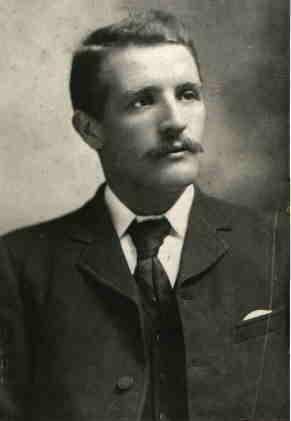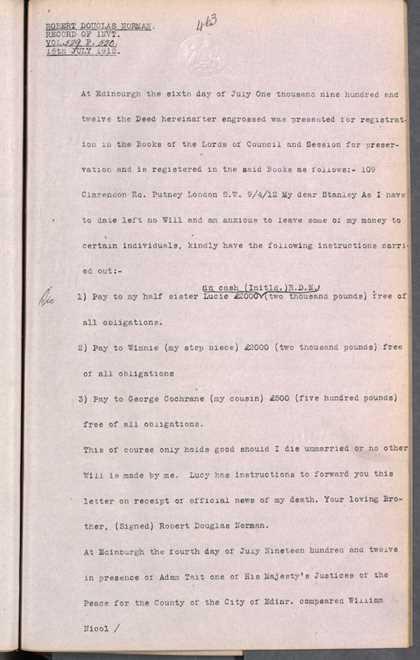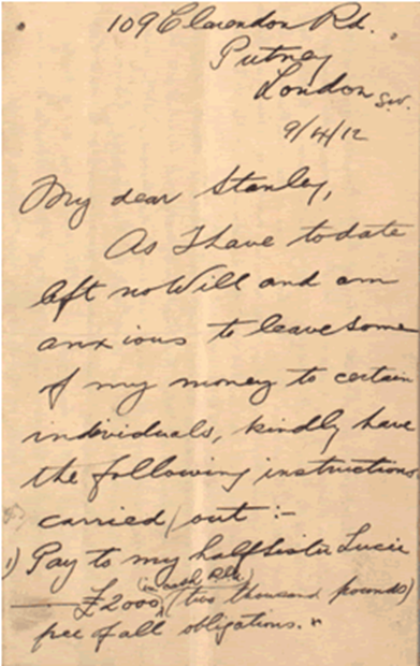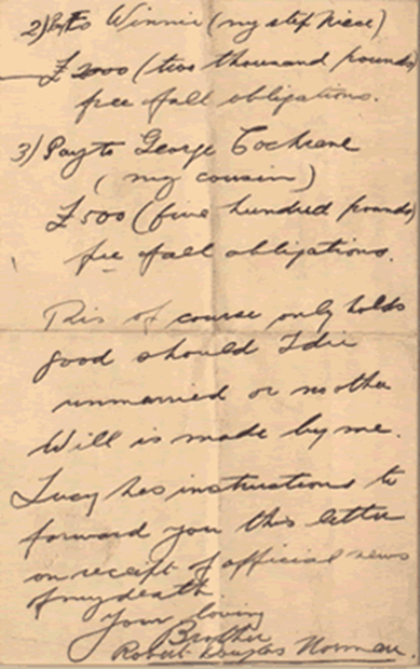The RMS Titanic, a British passenger liner that sank in the North Atlantic Ocean on her fateful maiden voyage early on 15 April 1912, is one of the most famous ships in history - her sinking became a defining event in the early twentieth century. Much about the vessel has been documented and even today the stories of the passengers continue to fascinate and intrigue. Many records relating to Scots who worked, sailed and died on the Titanic can be found through ScotlandsPeople and at National Records of Scotland.
On the maiden crossing there were 2,209 passengers and crew. Among those on board was William McMaster Murdoch.

Photograph of William M Murdoch
Credit: Public domain image via Wikimedia Commons
William was born on 28 February 1873 in Dalbeattie, Kircudbrightshire, into a family of seafaring men and sea captains. He joined the White Star Line in 1900, quickly became an officer, and was promoted to First Officer on the RMS Titanic.
He was one of 24 Scottish-born crew members out of 673 listed in the Returns of Deaths of Seamen in ScotlandsPeople. Like most of the crew, William is listed as living in Southampton. Scots seamen typically settled or lived in lodgings in the ports from which they sailed. The Returns can help us learn about Scots who were living and working outside Scotland, as well as provide us with the names of some of their fellow crew members. The Returns do not include passengers, so the majority of those who perished on the Titanic are not named in these records.

Entry in Deaths of Seamen for William M Murdoch on board the Titanic.
Crown copyright, National Records of Scotland, Statutory Register of Deaths (Marine Return), 37/MR100
There were eight musicians aboard the Titanic: a pianist, a bassist, three cellists, and three violinists one of whom was John Law Hume, born in Dumfries in 1890. He was the son of a music teacher, Andrew Hume, and his wife Grace Law.

Birth entry of John Law Hume, 9 August 1890
Crown copyright, National Records of Scotland, Statutory Register of Births, 821/353
John played in various bands before sailing on the Titanic, and he, along with his fellow musicians passed into legend thanks to survivors who told how they calmly continued to play until the ship sank. When the ship 'Mackay-Bennett' arrived to recover the bodies of the deceased from the ocean, they found Hume's body floating with two of his other band mates, John 'Nobby' Clarke and Wallace Hartley. John Hume had been engaged to marry Mary Costin when he returned from the voyage on the Titanic, and a week before he departed he discovered to his delight that she was pregnant. The tragedy of the Titanic would mean that he would never get to meet his daughter, Johnann Law Hume Costin who was born on 8 October 1912. As an unmarried woman, Mary had to fight for John to be recognised as father on the birth certificate. When John's father, Andrew, made it clear he did not approve of the relationship and resisted this registration, Mary was forced to take the case to Dumfries Sheriff Court. On 2 December 1912 an application for paternity was heard and granted, according to the records held in National Records of Scotland. This decision of paternity allowed Mary to appeal for a monetary grant from the Titanic Relief Fund, which supported Johnann financially, as it did for many other families of those lost at sea.
Among the passengers was Robert Douglas Norman, a 28 year-old electrical engineer from Glasgow, who was travelling second class on board the RMS Titanic from Southampton. He had recently resigned from his job with the A.E.G. Electric Company, and he planned to travel to Vancouver, where his brother George Stanley Norman lived, and where he had property interests.
While staying at his sister's house in London before boarding the Titanic, he wrote a letter to his brother in Canada. Despite claims the ship was unsinkable, the perils of sea travel must have concerned him, as he planned for the distribution of his estate. In a letter addressed to his brother George he specifies sums of money to be left to various relatives in the event of his death. His half-sister Lucy and step-niece Winnie were to be awarded £2000 each, and his cousin George Cochrane was to be awarded £500, so long as Robert should remain unmarried or make no further will. Sadly, this letter was to become his last will and testament as he was to perish six days later when the liner sank.

The will of Robert Norman
Crown copyright, National Records of Scotland, Records of Testamentary Deeds, SC70/4/439/463
Luckily, the original of this letter has survived because it was preserved for security in the Register of Deeds, as well as being authenticated and copied as part of the settlement of his estate. Robert had left instructions that, if he should die, his half-sister Lucy should forward the letter to his brother in Canada who was to act as his executor. When his estate was settled, the letter was authenticated and copied into the register of inventories in Edinburgh Sheriff Court. This copy can be found on the ScotlandsPeople website, the original was recorded and preserved in the Books of Council and Session, a legal register of the Court of Session, which can be seen in National Records of Scotland.


Letter from Robert Douglas Norman, 9 April 1912.
Crown copyright, National Records of Scotland, Warrants, RD15/1912/7/6
Members of the public reacted to the news of the sinking with bewilderment that such a modern and luxurious vessel could be lost. A letter by Burns MacDonald describes the sense of grief:
The latest sensation here is the terrible news of the loss of the Titanic which sped over the Country like wild fire, and today, authentic reports state that 1,500 of the crew and passengers went down with the big ship - Less than a week ago she sailed from Southampton in all her glory; the triumph of the shipbuilding art: fitted up with every conceivable design and device to secure comfort and safety. Today she lies at the bottom of the deep deep sea with most of her crew and male passengers; a noble tribute to their gallantry that they secured first the safety of the women and children but what a lot of sore and sad hears there will be amongst them.'
Letter from Burns MacDonald, Earnock, Perth, to John Stewart Peter, April 1912, GD391/20/22
Lady Betty Balfour also echoed the disbelief that the Titanic met such an end:
'I suppose one ought not to be more struck by size and the people on board, than if a fishing vessel was overwhelmed. But a ship with a racquet court, swimming bath... private promenade... does strike one.' (GD433/2/344/51)
Reports, like those above, of the gallantry of the crew and male passengers gave people comfort and helped them come to terms with the tragedy. Gradually, however, a fuller and darker picture emerged as the British Board of Trade's investigation proceeded.
For further information please read our guides on statutory registers of births, statutory registers of deaths and wills and testaments.